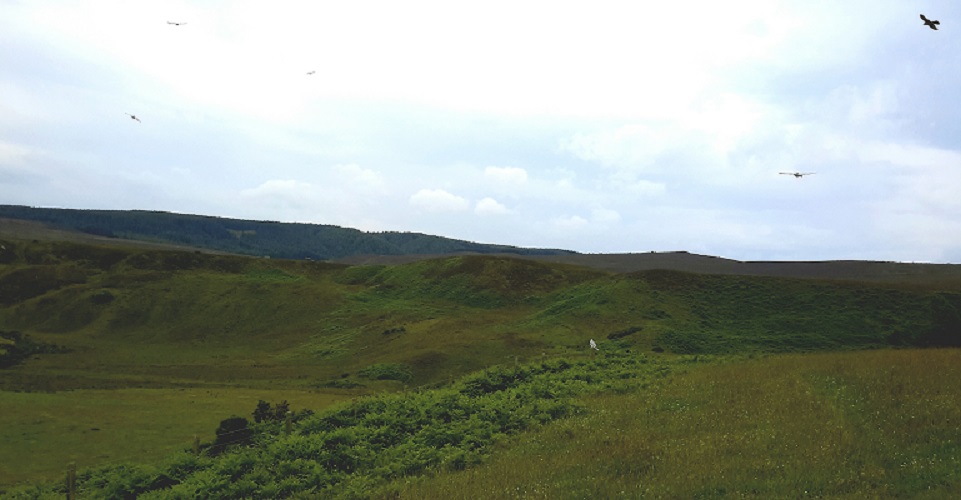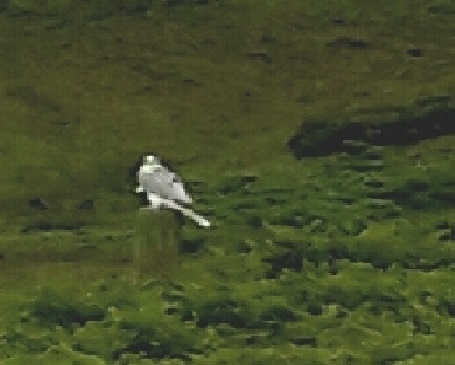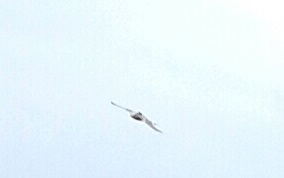I know that there are some readers of this blog who are finding it difficult to get their heads around the idea that there really were lots of Gyr Falcons released under SNH licence in a small part of Scotland this summer (with the intention that they should be taken back into captivity after a few weeks in the wild). (See also this blog from yesterday).
Here are some more images.

There are six large falcons in the image above – one on a fence post and five in the air (unless I’ve missed some!). In the two fuzzy enlargements below one can see the packs attached to the birds’ backs which were presumably the radio tags and the GPS recorders which were a condition of the licences and whose data will tell us so much more about where the birds go and for how long.


SNH has still not responded to the EIR request on these matters. But they have been quoted in a report from the ENDS report as stating that the wild hacking started at the end of June but I am told that this was not true this year (the only year in which these releases were licensed and therefore lawful, as I understand it). If wild hacking did start in late June then that was not a condition of the licence which permitted wild hacking of up to 150 Gyr Falcons from 1 June for three and a half months.
I understand that wild hacking (which has happened without licence in previous years) usually starts at the end of Ramadan when falconers arrive in Moray from Dubai – Ramadan ended on the evening of 4 June in 2019 (and will end on 23 May in 2020).
If SNH would like to comment on this matter then they are very welcome to a guest blog here (but we are all waiting with interest to see the response to the overdue EIR request too). The same offer applies to falconers involved with this type of enterprise or local residents with views on the matter. Here is some guidance for contributors – click here.
[registration_form]
Was there not a similar business operating in the Scottish Borders a few years ago (might still be there) which involved a planning application to which the GCWT objected but the RSPB didn’t?
De – there was a plan for such a business near Langholm I understand. I don’t know anything about who objected and who didn’t. Did the GWCT objection use the words NIMBY?
Living less than a km from the operation, I have clearly seen the impact on wildlife over the last three summers. Within one or two days of the falcons being released, the farmland and moorland birds disappear. Nesting activities and parenting duties seem to be abandoned or impossible due to the large number of falcons flying over the entire area. Native raptors are especially harrassed. I have recovered an injured Buzzard with an eye wound, witnessed others being mobbed and watched a Red Kite being driven away by a group of Gyr and Peregrines. Our usual Kestrel has failed to nest in my Kestrel box or nearby over the last couple of seasons.
Birds which visit our surrounding fields to forage move elsewhere. We have a breeding colony of Blackheaded gulls on a loch nearby who feed in large numbers within the glen. They disappear as soon as the falcons are present.
The summer sounds of Curlew, Lapwing, Oystercatcher, Buzzard and Skylark, are replaced by the course cries of captive bred falcons.
A wildlife report submitted to SNH was carried out on the 31st May – the day before the hacking licence was valid. It was done in haste – a “single walkover” 1km from the hacking pen. It only mentions the presence of Crossbills, woodland birds. They state “while they fly across areas of open ground to move between forest blocks, time spent outside forests is limited”. Does that imply any species outside the forest is at risk?
This report says that Hen Harrier and Merlin “might” have been present but may have been sitting on eggs within the 2km hacking range. I have watched Hen Harrier quartering the open moorland in winter months. There was no mention of any other farm or moorland birds. We also have a resident Barn owl within the 2km range. Several pairs of Curlew and a Curlew chick were seen in that area on 17th June when many falcons were flying around. Curlew and almost twenty other species in this glen are red listed birds. Absolutely no mention of these in this survey… why?
In an ENDS report an SNH spokesman stated the wild hacking takes place after the most vulnerable period for breeding waders. Not so. This is our normal breeding and rearing period at this latitude.
This practice of wild hacking is undoubtedly changing the balance of our native wildlife and impacting their breeding opportunities.
Andy – thank you very much for that local insight.
Yes,there was a breeding facility in Langholm that attracted more than 100 objections. As far as I am aware they never got permission to wild hack. One of the planning conditions prevented wild hacking. This just confirms what I have been saying – that it will affect people and more importantly the environment wherever it is proposed.
Is that the one in the Lowther Hills SPA?
Circus – I don’t know, not sure if Langholm is in the Lowther hills??
We know our local ground nesting birds are in trouble, and we have seen evidence of nests and chicks abandoned as soon as these captive bred birds of prey are released. The responsible SNH representative has been told about this on more than one occasion. Distressingly, it doesn’t seem as if it matters to SNH … you know, the organisation that is entrusted with looking out for Scotland’s natural heritage!
To anyone who cares about our natural environment and its indigenous wildlife, it should be straight forward. Our own natural spaces and their resident wildlife should come first. Every time!
It’s a sad indictment of our country’s priorities that we are even having this discussion. Deliberately imported birds of prey have no place here. They bring no benefit except to their owners, who only remove them at the end of the season, once the birds have increased in value and skill: attributes gained on the back of our natural spaces and wildlife.
After a damning report released earlier this year, about the state of Scotland’s wildlife, this cavalier attitude to its protection is staggering.
As far as I can see this is a strange business. Can someone actually tell me if there is any need for wild hacking? I know of a place in the borders who have big pens for the birds to fly but are contained and so no danger to any local wildlife. I had never heard of this before until recently but it seems to be a growing business. Sad for all our Scottish wildlife if its allowed to happen.
There probably isn’t any “need” for wild hacking it can all be done in large net covered pens, as is done elsewhere. Wild hacking is normally used in this day and age to rehabilitate injured birds from the wild or birds for re-introduction schemes. However it is almost certainly used by these people in their sales pitch to Arab clients and may be a major selling point, as these are the very same people who very recently insisted on wild taken birds..
Paul – I am a wildlife enthusiast. What do you mean by wild taken birds?
Either youngsters taken from wild nests, this was a huge problem in Central Asia a few years ago for Sakers and Altai Falcons and flying birds ( ie birds that can hunt) trapped in the wild again this was a huge problem. All much less of a problem for Gyr Falcons except in The Russian Federation where both were and may still be a serious problem. Birds trapped were often breeding adults so an even greater drain on wild populations.
Blue B; I think Paul means young birds taken from the nest – but I stand to be corrected.
Wild hacking will be takign place if they have too many birds to train. It’s a cheap way of getting them back to flying weight it as they let them out and can forget about them instead of having to take time training the birds.
Basically, if you keep a bird of prey you’ll feed it with much more food when they’re dropping their feathers and growing new ones because their feathers are much stronger that way. Birds of prey in the wild can have weaker feathers with stress marks if they have struggled to find anough food naturally.
A falconer will give the bird enough food until it doesn’t want any more food, for instance they may give the bird 4 day old chicks during the flying season and then go up to 7 or 8 and will drop that number back once the bird is no longer eating them all.
Once the feathers are grown in strong and the bird is ready to fly the weight needs to be dropped again or the bird will show no interest in hunting. They’re like us in that respect, we eat until we’ve had enough and then we stop until we’re hungry again.
You need to drop the weight until the birds are hungry and then you have to train them to come back to you every year and that takes time, a lot of time of you have a lot of birds. A lot of time costs a lot of money if you’re running a business.
These birds are likely to have been given medication if they’re being hacked this early as it’s usually September or later when most falconers start training their birds.
Mick – I think I read these falcons are bred then wild hacked to toughen them up for export so not sure this is the same thing you are talking about.
I would think if 40 Gyr falcons are left out with no handler they would most certainly be a threat to our native wildlife.
Why would they have too many? Surely breed less then.
Obviously money before ecology Again.
These birds are untrained just fledging juveniles not trained birds or birds in training. Apart from being manned they will probably remain untrained until bought by clients.
Has anyone posting comments actually contacted the people doing the hacking to get a better understanding of what hacking involves? There seems to be a lot of misunderstanding and accusations but without any knowledge and understanding of why hacking takes place.
Paul – does there?
Yes, I think so from reading the comments. I have hacked falcons in the early 90s and so have some experience, and would say many of the comments are inaccurate. For example, hacking doesn’t start at the end of Ramadan. It starts when the captive bred falcons are ready to be hacked, ie when they have fledged. Has anyone contacted the people doing the hacking to get a better understanding?
Paul – your hacking may not have started at the end of Ramadan but then you weren’t, I’m guessing, a Muslim flying in from the Middle East to do it? The end of Ramadan and fledging are going to be similar times most years. Was that the ‘many’ inaccurate comments? It would be god to benefit from your greater experience.
Paul Thompson, yes. It has been explained. It is also pretty obvious when the birds go out and how they behave during the hack. They don’t keep their aerial displays private and the sudden disappearance of local ground nesting birds also bears testament to the abnormal numbers of flying predators.
But the REAL point is that thorough and appropriate pre-license impact and sensitivity studies are not being carried out,. Across the country, non-native raptor species are being flown in large numbers without any license at all. The whole licensing process is completely flawed.
Not that the wholesale sellout of British wild spaces in the interests of a few is ever acceptable, though it’s happening with frightening acceleration. It seems the priorities of the bodies responsible are highly questionable.
Paul Thomson – yes.
Paul Thomson – Andy already said yes. I met with the falconers last July and the meeting explained all about hacking and their telemetry system. The meeting didn’t go too well when I asked them to keep the birds out of my garden. They replied ‘we can’t do that, buy a water pistol to scare them away”……. seriously? I was also told after asking if they had a licence “no we don’t need one”. Experienced falconers told me they didn’t need one but I knew they did after speaking to RSPB earlier that year about my concerns for our wildlife. At that time they were flying hybrids too. I have lived with ‘wild hacking’ so I know enought about it and want to know no more. I wonder what SNH are thinking letting this happen. You did wild hacking in the 90’s? Did you have a licence? Please tell us where you did it? Was it up to 40 falcons flying free for weeks? If not you are talking about a completely different thing.